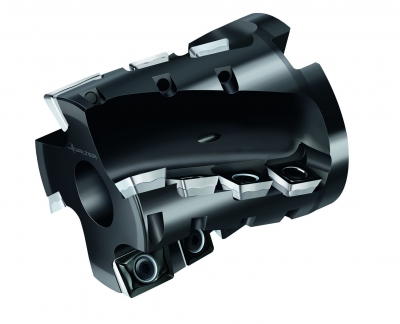
Walter has announced the addition of the M4256, M4257 and M4258 high-performance helical milling cutters to its M4000 family. The M4000 program offers the advantages of a system insert concept that allows one insert style to be used in a variety of tools, permitting a wide array of milling operations. Using a system insert not only reduces the cost per cutting edge, but also the time and costs involved in inventory requirements. With the addition of new M4256, M4257 and M4258 helical milling cutters, Walter is offering the same advantages for slot milling as well. The new milling cutters can also be used for ramping, pocket milling, shoulder milling and circular interpolation.
The new cutters are versatile not only in terms of applications but in terms of materials as well. Standard inserts are available for applications in steel, cast iron, stainless steels and difficult-to-cut materials. Mounting configurations are available with Weldon shank, modular ScrewFit interface and shell mill adaption.
Effective chip evacuation is assured thanks to generous chip clearance which is integral to these helical milling cutters. Working under low cutting pressure, their compact length and effective design promotes smooth operation. This reduces the tendency to oscillate and vibrate, making them the ideal solution for a variety of unstable machining conditions, benefits which pay extra dividends when combined with the system’s D51 geometry insert. The D51 boasts an antivibration chamfer that promotes smooth machining operations.
Contact Details
Related Glossary Terms
- chip clearance
chip clearance
In milling, the groove or space provided in the cutter body that allows chips to be formed by the inserts.
- clearance
clearance
Space provided behind a tool’s land or relief to prevent rubbing and subsequent premature deterioration of the tool. See land; relief.
- gang cutting ( milling)
gang cutting ( milling)
Machining with several cutters mounted on a single arbor, generally for simultaneous cutting.
- interpolation
interpolation
Process of generating a sufficient number of positioning commands for the servomotors driving the machine tool so the path of the tool closely approximates the ideal path. See CNC, computer numerical control; NC, numerical control.
- milling
milling
Machining operation in which metal or other material is removed by applying power to a rotating cutter. In vertical milling, the cutting tool is mounted vertically on the spindle. In horizontal milling, the cutting tool is mounted horizontally, either directly on the spindle or on an arbor. Horizontal milling is further broken down into conventional milling, where the cutter rotates opposite the direction of feed, or “up” into the workpiece; and climb milling, where the cutter rotates in the direction of feed, or “down” into the workpiece. Milling operations include plane or surface milling, endmilling, facemilling, angle milling, form milling and profiling.
- milling machine ( mill)
milling machine ( mill)
Runs endmills and arbor-mounted milling cutters. Features include a head with a spindle that drives the cutters; a column, knee and table that provide motion in the three Cartesian axes; and a base that supports the components and houses the cutting-fluid pump and reservoir. The work is mounted on the table and fed into the rotating cutter or endmill to accomplish the milling steps; vertical milling machines also feed endmills into the work by means of a spindle-mounted quill. Models range from small manual machines to big bed-type and duplex mills. All take one of three basic forms: vertical, horizontal or convertible horizontal/vertical. Vertical machines may be knee-type (the table is mounted on a knee that can be elevated) or bed-type (the table is securely supported and only moves horizontally). In general, horizontal machines are bigger and more powerful, while vertical machines are lighter but more versatile and easier to set up and operate.
- shank
shank
Main body of a tool; the portion of a drill or similar end-held tool that fits into a collet, chuck or similar mounting device.
- stainless steels
stainless steels
Stainless steels possess high strength, heat resistance, excellent workability and erosion resistance. Four general classes have been developed to cover a range of mechanical and physical properties for particular applications. The four classes are: the austenitic types of the chromium-nickel-manganese 200 series and the chromium-nickel 300 series; the martensitic types of the chromium, hardenable 400 series; the chromium, nonhardenable 400-series ferritic types; and the precipitation-hardening type of chromium-nickel alloys with additional elements that are hardenable by solution treating and aging.







